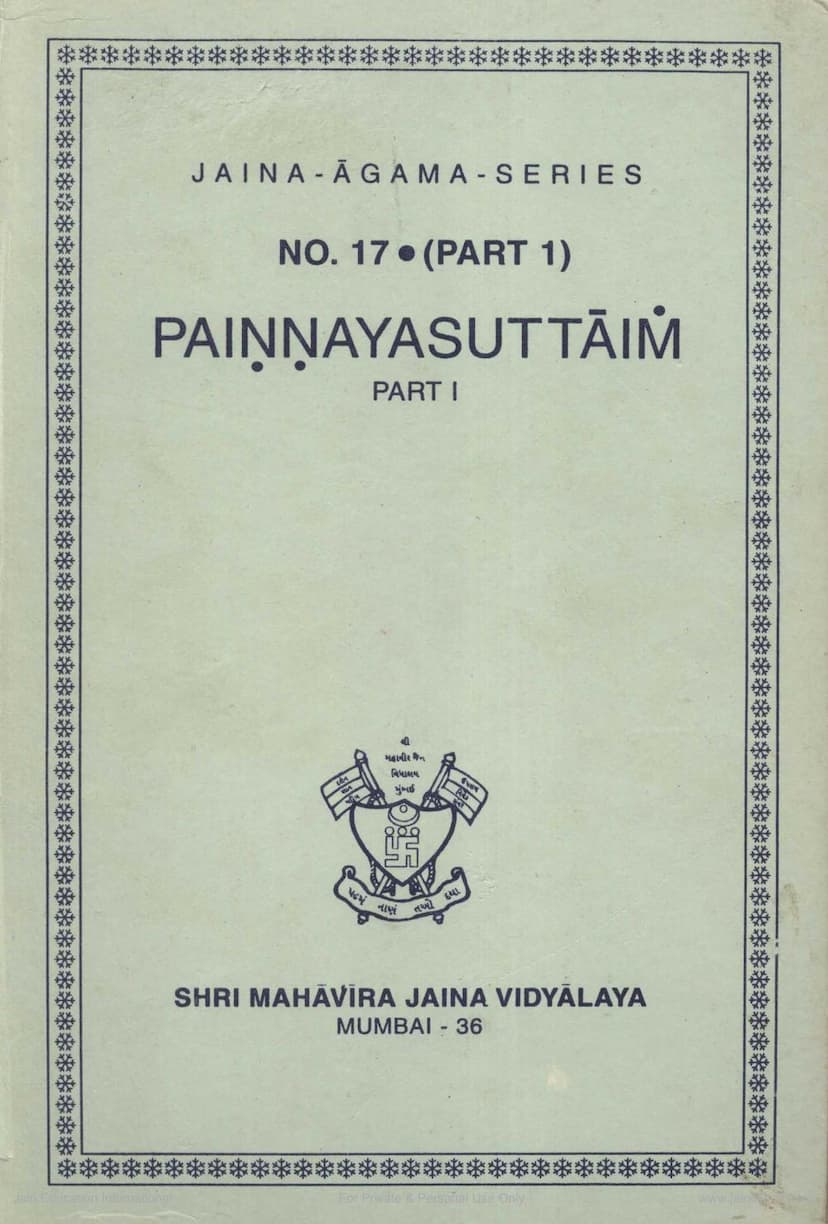Painnay Suttai Part 1
Added to library: September 2, 2025

Summary
The Jain text you've provided, "Painnay Suttai Part 1," is a significant work in Jain Agamic literature, specifically focusing on the Prakirnaka (Painnaya) division. Here's a summary based on the provided text:
Book Title: Painnay Suttai Part 1 Author(s): Muni Punyavijay, Amritlal Bhojak Publisher: Mahavir Jain Vidyalay
Overall Focus: This volume is part of a larger series aimed at publishing Jain Āgamas. Part 1 of Painnay Suttai focuses on the Prakirnaka (or Painnaya) texts. The Prakirnaka literature within the Jain Āgamas is characterized by its diverse and often esoteric subject matter, covering a wide range of topics beyond the core doctrines, and its compilation over different periods. This particular volume presents twenty such Prakirnaka texts.
Key Aspects and Content Highlights:
-
Editorial Foundation: The preface emphasizes the critical work done by the late Muni Shri Punyavijayaji in collecting manuscripts, noting textual variations, and preparing recensions of these Prakirnaka texts. Due to his passing, the monumental task of finalizing the editing was completed by Shri Amritlal Mohanlal Bhojak, under the guidance of the Mahavir Jain Vidyalaya.
-
The Prakirnaka Collection: The volume contains twenty Prakirnaka texts. The introduction clarifies the historical context of these texts, noting that while ancient traditions (like the Nandisutra and Paksikasutra) mention eighty-four Āgamas, the current count is forty-five. It highlights that many Āgamas named in older traditions are now lost, while newer ones, some dating to the 11th century, have been included in the current list. The Nandi Sutra classifies all Āgamas except the Angas as Prakirnakas.
-
Authorship and Chronology: The text notes that Āgamas, other than the Angas, were composed at various times by different ācāryas and sthaviras (senior monks). Specific authors are mentioned for some texts, like Syamaraya for Pannavana, Arya Bhadrabahu for Dashā, Kalpa, and Vyavahara, and Virabhadra for works like Causarana, Aurapaccakkhana, and others, with approximate dates for some.
-
Key Prakirnaka Texts Included (Based on the Granthānukramaḥ - Table of Contents):
- Chattarimangal Sutra: A foundational text invoking the auspiciousness of the Arhats, Siddhas, Sadhus, and the doctrine taught by the Kevalins.
- Devindatthaya (Devendrastava): A text that appears to describe the celestial beings (Devas), their numbers, locations, and lifespans, likely presented in a dialogue format.
- Tandulaveyalïya: Discusses the physical and biological aspects of human life, from conception to birth, including details about the embryo, diet, and human development.
- Chandāvejjhaya: Focuses on the virtues of vinaya (humility/discipline), ācārya (teacher), śiṣya (disciple), knowledge, conduct, and death, emphasizing the importance of character and spiritual discipline.
- Ganividya: Deals with auspicious timings and calculations related to astronomical phenomena, astrological predictions, and their influence on various activities like initiation, fasting, etc.
- Marana Vibhakti (Maranasamaadhi): Explores the nature of death, classifying it into auspicious and inauspicious types, and providing detailed guidance on achieving a peaceful and spiritually beneficial death (panditamarana) through practices like confession, penance, and detachment.
- Āturapracchayāna: Discusses rituals and practices related to preparing for death, particularly for the terminally ill or aged, emphasizing the importance of renunciation and spiritual reflection. This text appears in multiple parts ([1], [2], [3]) within the volume, indicating variations or distinct sections.
- Mahapracchhyana: Focuses on great renunciations, including details about various forms of renunciation and their spiritual significance.
- Isibhāsiyāi: A collection of teachings and discourses attributed to 45 sages (Rishis) who attained self-realization, covering topics like non-violence, truth, renunciation, control of senses, and the nature of existence. The text acknowledges potential variations in the number of adhyayanas mentioned in different traditions.
- Lalita (Gacchāchāra): Discusses the conduct and discipline of Jain monastic communities (Gachhas), outlining the characteristics of virtuous and errant monks and nuns.
- Sārāvalī: Seems to be a eulogy or description of significant Jain pilgrimage sites, particularly Śatruñjaya (Pundrikagiri), detailing its importance and the merits associated with visiting it.
- Jyotiṣkaraṇḍaka: A technical text on Jain astrology and astronomy, detailing celestial bodies, their movements, calculations of time, auspicious timings, and prognostication.
- Tithoogāli: A text that deals with cyclical time, the periods of progression and regression of epochs (avasarpiṇī and utsarpini), and the characteristics of different stages of human life, including historical narratives and lineages.
- Viratthao: A hymn or eulogy to Lord Mahāvīra, enumerating his various names and virtues.
- Kusalaanubandhi Adhyayana: Discusses virtuous conduct and its consequences, emphasizing the importance of right knowledge, conduct, and the renunciation of passions.
- Āturapracchayāna [1], [2]: Texts related to death rituals and practices, possibly with variations or covering different aspects of the dying process.
- Mahapracchhyana: Another text dealing with renunciation, possibly of a more profound or extensive nature.
- Vaitthya: Discusses virtues and conduct, possibly related to the practice of Jainism.
- Gata Rātricarya: This title suggests a text discussing the conduct during the night, potentially related to monastic observances.
- Upaśama: This title implies a text focused on equanimity, calmness, or cessation of passions.
- Dharmakriya: This title points to the practices and rituals within Jainism.
- Kramabaddha: Suggests a text dealing with sequential order or progression.
- Païannaka: This is a general term referring to the Prakirnaka literature itself.
-
Scholarly Apparatus: The volume includes detailed introductions, critical notes, and descriptions of manuscripts, reflecting a rigorous scholarly approach. The editors acknowledge the contributions of various scholars and institutions that supported this publication.
-
Financial Support: The publication was made possible through the generous donations from various Jain trusts, sanghs, and individuals, underscoring the community's commitment to preserving and disseminating Jain literature.
In essence, "Painnay Suttai Part 1" serves as a vital resource for understanding the diverse and intricate secondary literature within the Jain canon, showcasing detailed information on celestial calculations, conduct, philosophical discussions, and practices related to spiritual discipline and the ultimate goal of liberation, all critically edited and presented for academic and personal study.